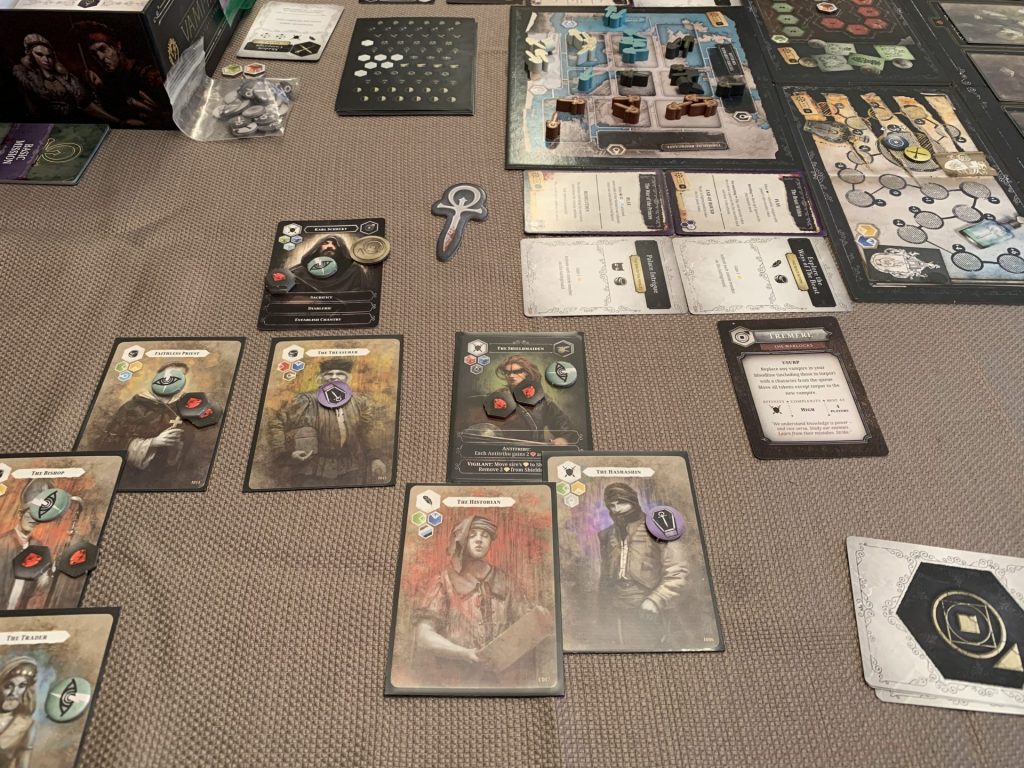Vampire: The Masquerade is a venerable series. Beginning with the Vampire: The Masquerade tabletop roleplaying game in 1991 as part of the wider World of Darkness setting, Vampire has grown to encompass numerous video games, RPGs, and now board games like Vampire: The Masquerade – Rivals. In the RPGs of Vampire: The Masquerade, players enter a detailed modern world of secret vampire societies, ancient clans, and The Masquerade, a set of rules passed down for generations to ensure the secrecy of vampirism across the globe.
Vampire: The Masquerade Heritage is an interesting addition to this universe. As a stand-alone experience, a game of Heritage involves players taking control of a singular clan with unique missions and actions. Players then attempt to simultaneously earn prestige by winning control over three small boards and completing the overall objectives listed at the top of the main board. To do this, players must acquire vampires with diverse skills and traits, and use them to enact plots.
The main mechanic to accomplish these goals is through the game’s tableau builder. A row of potential new vampires awaits below the game’s overall objectives, each with their own set of traits and a key skill. Traits include home region, disposition, and whether they are high or low born. Skills come in broad flavours like economy, military, and espionage. When a new vampire is chosen from the tableau, it is placed beneath another, symbolizing that it is the “Childer” to that vampire, meaning they were turned by it. This creates an ever-expanding pyramid of vampires, each of which can be activated along with their direct children to enact a plot. When a new vampire is added, it’s traits influence the three boards, shifting a player’s tokens to potentially gain or lose points when a plot is activated.

These plots can be as simple as the board activation noted above, or as complicated as marking an enemy vampire in another clan to prepare them for a future assassination plot. Choosing the correct candidates to join your ever-growing clan and enacting plots to achieve success is the heart of the game, but so much of what this system can do fails to show itself unless you play Heritage as a legacy game.
Vampire the Masquerade Heritage really should be played as such. Each player takes a RPG-like character sheet and creates the skeleton of their avatar. Players are born into the 14th century and belong to no real clan, being siblings who have just killed their powerful sire (The Vampire who turned them). Now, players must connect with the varied clans of Vampire the Masquerade lore and use them to advance themselves through the centuries. Legacy games add so much to the base mechanics of Heritage that it quickly becomes clear that any play outside of the bounds of legacy is not worth the effort.

In each legacy game players set out to accomplish several narrative objectives as well as earn the most prestige to emerge the victor, just as in the base game. The difference here is that each narrative objective, being a fun vampire-tainted historical tidbit, like turning Da Vinci into a creature of the night or protecting your flock from the Black Death, also grants long term benefits that add to a player’s character sheet and affect future games.
Clans also grow as they are played during legacy games, with new plots and leaders added to clan decks as games progress. Similarly, the vampires that are recruited each game have the option of improving in power and status, giving them special actions that occur when they’re taken into a clan. This starts simple, but as games progress the number of interesting vampires with interesting abilities grows, allowing for some complicated tactical decision making that really makes Heritage shine as a tableau builder.

That the lore of the group grows and develops with each play just adds to the joy. I will never abandon my shield maiden, my first vassal and now a fully decked out character. But I will always hate the disillusioned monk, who never seems to miss screwing up my plans. While the game grows because of the changing vampire and clan cards, it also develops as the narrative timeline of the game advances. New vampires are added to the deck, and the three basic games that are played change as the story of the vampire clans changes from a bid to control Europe to a wider quest for control of the world’s vampires.
This is the way the game was meant to be played, and it shows. A legacy game of Vampire lasts 21 games, plenty to get your money’s worth from the package, and plenty of time to get into the growing narrative that springs up out of play. In our experience though, we did games in batches. The similarities in the core mechanics of the game, while made different because of the legacy elements, still wasn’t as engaging as I would have liked. I suppose it boils down to the tableau builder mechanic. The basic actions are quite simple, and without the endurance of the legacy game to give them more meaning, they fall a little flat. Another issue is that the different clans are very situational in their abilities. Some are almost useless at two players but perform amazingly at four. Others can be swamped by more than two players. It keeps things interesting, but the best way to play was by enjoying the ups and downs of each player’s character vampire. Though there isn’t much interaction besides the ability to upgrade certain vampires based on the skills of the player character, but it helps soften the blow of poor performance.












Add Comment